Joint Autonomous Universities Graduate Employment Survey 2023
HEALTHY EMPLOYMENT OUTCOMES AMIDST SLOWER ECONOMIC GROWTH
Singapore, 22 February 2024 - The results from the 2023 Joint Autonomous Universities Graduate Employment Survey (JAUGES)1 – conducted by National University of Singapore (NUS), Nanyang Technological University (NTU), Singapore Management University (SMU), and the Singapore University of Social Sciences (SUSS) – showed an increase in median gross monthly salaries compared to previous years despite a moderation in employment rates amidst slower economic growth.
Employment Indicators for Fresh Graduates from Full-Time Programmes
2. About 12,300 recent graduates from full-time programmes at NUS, NTU, SMU and SUSS took part in the 2023 survey, accounting for a response rate of 74.0%. They were surveyed on their employment status as at 1 November 2023, approximately six months after the completion of their final examinations.
3. Among the 10,900 respondents in the labour force2, 89.6% were employed within six months of completing their final examinations, compared to 93.8% in 20223. Of these, 84.1% were in full-time permanent employment, compared to 87.5% in 2022. Additionally, 1.5% were freelancing, compared to 1.8% in 2022. For comparison, in the three years prior to the pandemic (2017 – 2019), an average of 89.9% of the respondents in the labour force were employed, with 80.4% in full-time permanent employment, and 2.1% freelancing.
4. The proportion in part-time/temporary employment was 4.0%, compared to 4.5% in 2022. 1.1% were in involuntary part-time/temporary employment in 2023, compared to 0.8% in 2022 (see Table 1 for a breakdown of these figures).
5. The median gross monthly salary3 among fresh graduates in full-time permanent employment was $4,313, compared to $4,200 in 2022.
_______________
1The JAUGES is conducted by the six Autonomous Universities (NUS, NTU, SMU, SUTD, SIT and SUSS) every year to collect information on the employment status of graduates, around six months after the completion of their final examinations. Due to their different academic calendars, NUS, NTU, SMU and SUSS conduct their surveys in November each year, while SIT conducts its survey in March. Given the small graduating cohort, SUTD will conduct a survey in November 2024 where it will include graduates from both the 2023 and 2024 batches — the results of which will be reported alongside the Joint AU 2024 GES results in February 2025 (see para 12).
2Graduates in the labour force refer to graduates who are either employed (i.e., working) or unemployed (i.e., not working but actively looking and available for a job).
3Refer to Appendix I for the definitions of employment indicators.
Table 1: Employment Indicators of Fresh Graduates from Full-Time Programmes (NUS, NTU, SMU, SUSS)
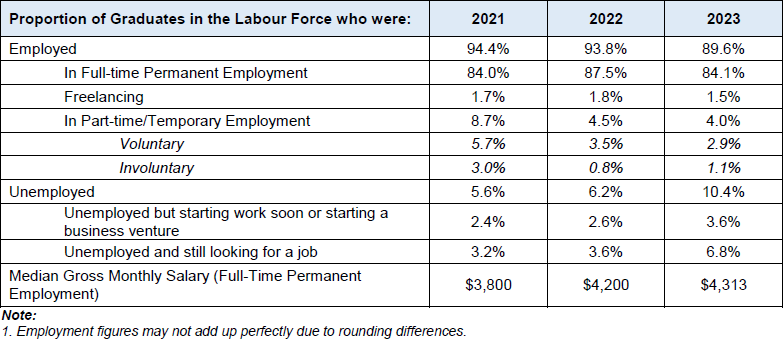
Employment Outcomes by Course Cluster
6. In 2023, the Health Sciences, Information & Digital Technologies, and Business clusters recorded the highest full-time permanent employment rates. All clusters recorded higher median gross monthly salaries in 2023 except for the Engineering and Information & Digital Technologies clusters (refer to Table 2 for details).
Table 2: Employment Indicators of Fresh Graduates by Course Clusters (NUS, NTU, SMU, SUSS)4
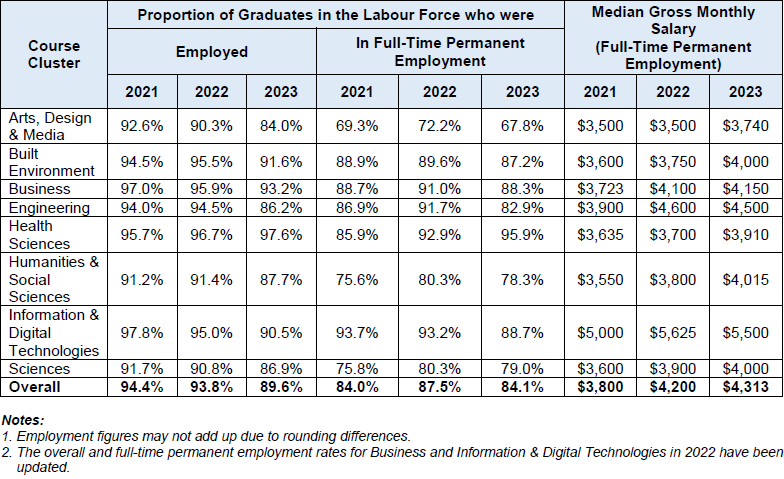
_______________
4Appendix II lists all courses under each course cluster. The survey findings of respective AUs can be found at https://www.moe.gov.sg/post-secondary/overview/autonomous-universities/
Employment Status of Graduates who Participated in the Follow-up Survey 7. Close to 700 graduates from NUS, NTU, SMU and SUSS participated in the 2023 follow-up survey which surveyed their employment status as at 1 November 2023, representing a response rate of 58.7%. The survey is conducted for courses that typically require post-graduate practical training before the graduates can practise in their professions. These graduates were from:
(i) The Architecture Class of 2020, who took part in the survey upon completion of their practical training, and
(ii) The Biomedical Sciences and Chinese Medicine, Law, Medicine, and Pharmacy courses, who took part in the survey after completing their one-year practical law course, pupilage, or housemanship/first-year residency training upon graduation in 2022.
8. Of those in the labour force, 97.2% were employed after the completion of their practical training/housemanship/first-year residency training, compared to 97.4% in 2022. 96.5% of those in the labour force secured full-time permanent employment, compared to 94.9% in 2022. Another 0.2% were freelancing, compared to 0.8% in 2022.
9. The proportion in part-time/temporary employment was 0.6%, compared to 1.7% in 2022. The proportion who were in voluntary part-time/temporary employment was 0.6% in 2023, compared to 1.2% in 2022 (see Table 3 for a breakdown of these figures).
10. The median gross monthly salary of those in full-time permanent employment was $6,000 in 2023, compared to $5,500 in 2022.
Table 3: Employment Indicators of Graduates who participated in the Follow-Up Survey
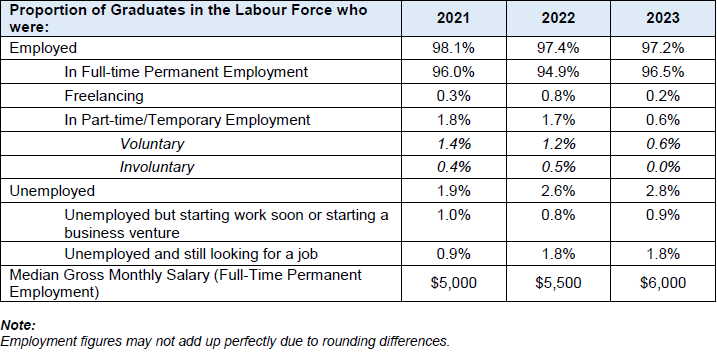
Results for Singapore Institute of Technology (SIT) & Singapore University of Technology and Design (SUTD)
11. SIT’s results will be released at a later date, as its survey will be conducted in March 2024.
12. Due to a change in SUTD’s academic calendar from AY2020, the graduating class of 2023 comprises SUTD graduates from only the SUTD-SMU Dual Degree Programme and the Architecture and Sustainable Design programme. Given the small graduating cohort, SUTD will conduct a survey in November 2024 where it will include graduates from both the 2023 and 2024 batches — the results of which will be reported alongside the Joint AU 2024 GES results in February 2025.
For media queries and interviews, please contact:
NTU Media Contact
Foo Jie Ying
Assistant Director,
Corporate Communications Office
Nanyang Technological University
Email: jieying@ntu.edu.sg
NUS Media Contact
Gayathri De Silva
Manager,
Office of University Communications
National University of Singapore
Email: gayathri.desilva@nus.edu.sg
SIT Media Contact
Jesmine Ong
Assistant Director,
Corporate Communications
Singapore Institute of Technology
Email: Jesmine.Ong@SingaporeTech.edu.sg
SMU Media Contact
Audrey Chan
Senior Manager,
Corporate Communications
Office of Corporate Communications and Marketing
Singapore Management University
Email: audreychan@smu.edu.sg
SUSS Media Contact
Edward Poh
Senior Manager,
Communications & Marketing
Singapore University of Social Sciences
Email: edwardpohm@suss.edu.sg
SUTD Media Contact
Melissa Koh
Manager (Public Relations),
Office of Marketing and Communications
Singapore University of
Technology and Design
Email: melissa_koh@sutd.edu.sg
APPENDIX I: DEFINITION OF EMPLOYMENT INDICATORS
Employment refers to graduates working on a full-time permanent, part-time, temporary employment or freelancing basis.
Full-time Permanent Employment refers to employment of at least 35 hours a week and where the employment is not temporary. It includes those on contracts of one year or more.
Freelancing refers to those who operate their own business without employing any paid worker in the conduct of their business or trade.
Part-time Employment refers to employment of less than 35 hours a week.
Temporary Employment refers to casual, interim or seasonal employment, including those on contracts of less than one year.
Involuntary part-time/temporary employment refers to those who indicated that they were in part- time/temporary employment as they had tried but were unable to obtain a full-time permanent job offer so far.
Voluntary part-time/temporary employment refers to those who indicated that they were in part- time/temporary employment as they were pursuing/preparing to commence further studies, as they were taking active steps to start a business venture, due to personal choice, or other reasons.
Unemployed but starting work soon refers to those who indicated that they were not working as they had accepted a job offer and will start later, or were taking steps to start a business venture.
Unemployed and still looking for a job refers to those who indicated that they were not working but actively looking and available for work.
Gross Monthly Salary comprises basic salary, fixed allowances, over-time pay, commissions and other regular cash payments, before deduction of the employee’s CPF contributions and personal income tax. Employer’s CPF contributions, bonuses, stock options, other lump sum payments and payments-in-kind are excluded.
APPENDIX II: LIST OF COURSE CLUSTERS AND COURSES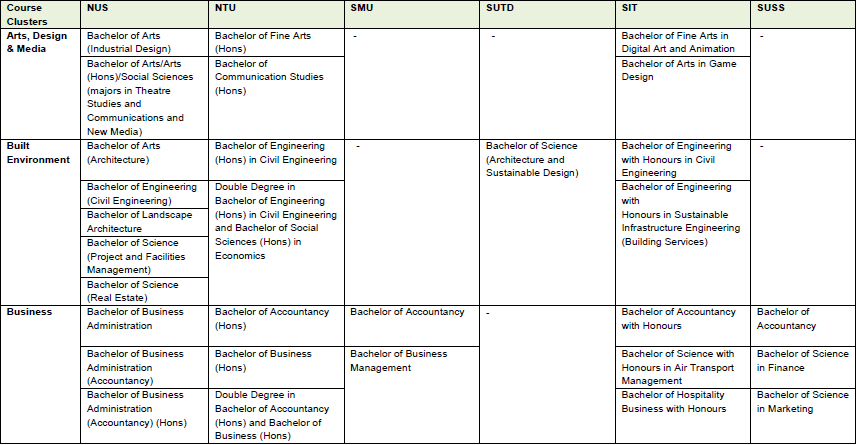
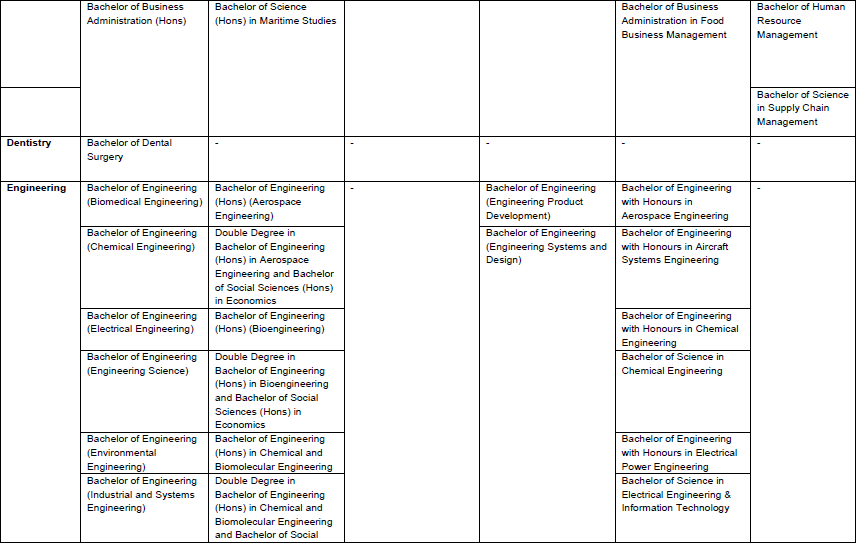
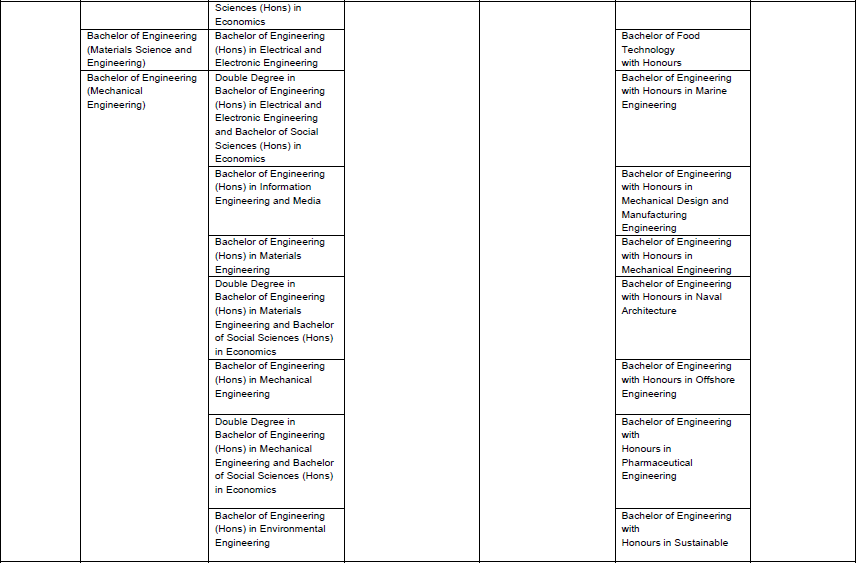
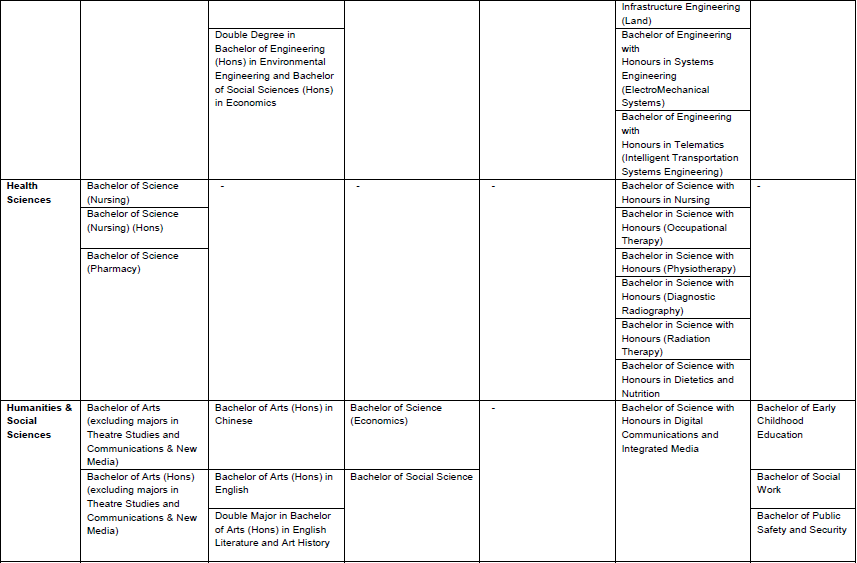
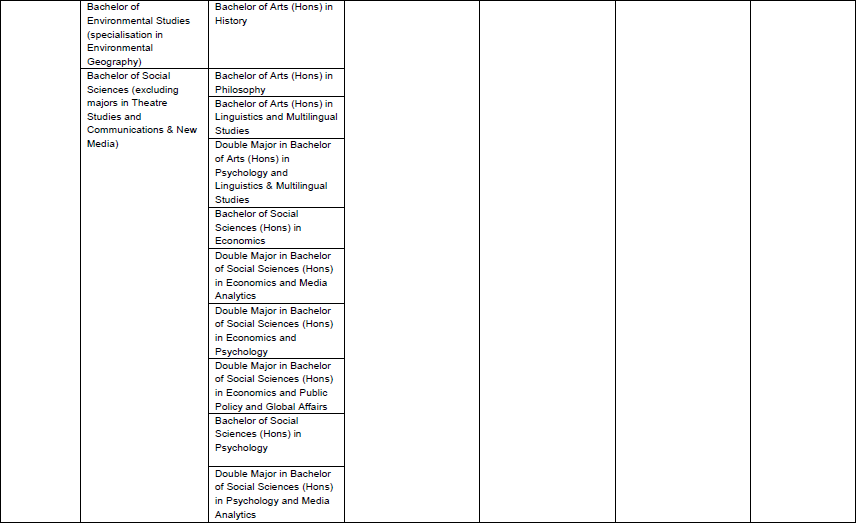
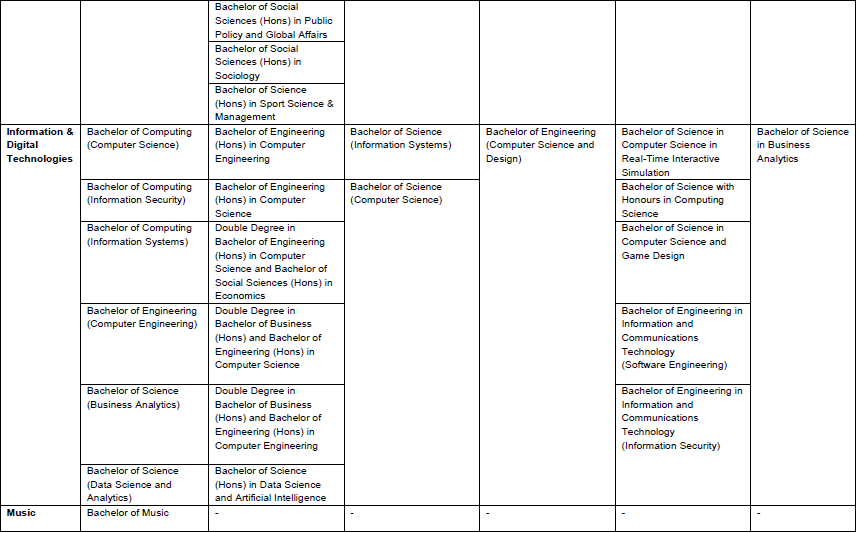
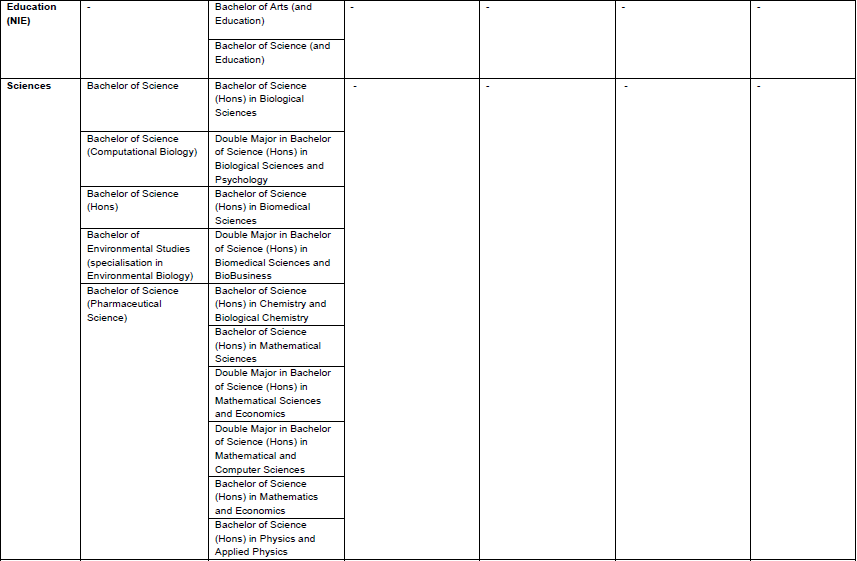

FOLLOW-UP GRADUATES